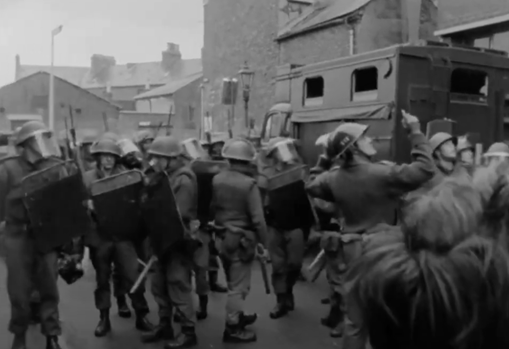
By Mx Kris Vyas-Myall
More than 1,000 women marched through armed cordons in Belfast a few days ago, in a surprising display of bravery and protest. How has such an act come to be seen on British streets?

Since last summer, when British troops were called in by Stormont, the violence has continued to worsen. When the so-called “battle of the bogside” took place in August, British troops arrived too late to stop loyalist violence.
Soon after, a split emerged in December within the IRA, with there now being two groups. First are the “official” IRA, who have adopted a Marxist platform and believe in political engagement to bring about a socialist workers republic. Second are the new militant “provisional” IRA who support armed defence of Catholic communities and believe that their campaign can only end in a single united republic of Ireland. Currently, the momentum seems to be with the provisional group, particularly with increasing loyalist violence. When a member of the official IRA came out to ask a Catholic group to disperse, he was stoned by the crowd.
Things have also been going south (pun intended) in the Republic. In April, a paramilitary group (possibly the provisional IRA or Saor Eire, but unconfirmed) committed a bank robbery and shot dead an unarmed member of the Irish Garda, Richard Fallon, the first to be murdered in the line of duty since the 40s. The next month, Jack Lynch, the Irish Taoiseach, was forced to fire his ministers of finance and agriculture as they are charged with trying to supply arms to paramilitaries in the North.
As tensions continued to ramp up between communities, it was inevitable we were in for another summer of violence. In the most recent incident, it is unclear as yet who struck first. Loyalist sources say the provisional IRA were using the imprisonment of Bernadette Devlin as an excuse to whip up violence. Republican sources say a loyalist mob were trying to drive Catholics living in the Short Strand area out of East Belfast. Whatever the cause, five people died and there was a huge amount of property damage. More importantly for what happened next, members of the provisional IRA used guns to fire back against loyalists in the Falls Road area.
A curfew was declared in the area as three thousand British Army went house to house, armed and firing tear-gas, in order to check for weapons and arrest potential IRA suspects. This, however, is not something that can be done quickly (there were more houses than soldiers) or easily, and took three days to complete. As such, supplies were running low for some households, as people even leaving to get food were liable to be shot.
This is where the march came in. Local Catholic women decided to take action themselves and marched in holding food, in full view of the press. They correctly made the calculation that the British Army would not shoot women armed only with bread and milk to be broadcast on the evening news. Some were blocked but many were able to get through and resupply the community.

It is unclear if the British raids will have done any more than American finding of caches in Vietnam but two things are definitely clear:
1. The Catholic community in the North are not going to have much trust of the British to protect them, if any indeed still remained.
2. Protection and support for the community is coming from the ground up, particularly women in these roles, rather than top down.
One place you can also see women regularly pushing things forward is in Orbit. Whilst not quite having an equal number, it is still the only place I can be certain to see multiple women writers between its two covers.
Orbit 7 ed. by Damon Knight

Cover by Paul Lehr
April Fool's Day Forever by Kate Wilhelm
The best way to describe this novella is that it is about a series of odd events. Julia and Martie lost two babies and are trying again, but they occasionally think they hear an infant crying. Whilst he thinks there must be a rational explanation for what is making the sound, she believes there is another place where their children are alive. All over the world, cold weather and disease epidemics are emerging but science, news and travel are being mysteriously tightened up. Julia goes to check out hospitals and finds them staffed by people who are unbelievably young, and all books on obstetrics have vanished.
Hilary Boyle, Martie’s boss, thinks all this relates to a possible immortality treatment. One of which no mention has been made of in years and the person who led the project mysteriously died shortly after the announcement.
The work I was most reminded of whilst reading this was Nevil Shute’s On The Beach–not in the plot but in the weird mix of normality with the overwhelming sense of inevitable doom. As if, at any moment, you may die but you still need to make sure the dishes are finished. However, taking up a third of the anthology, it is far too long for my tastes. And by the time it started discussing Jung I was willing it to end.
A high Two Stars
As Eyebem, a robotic ranger, lies in a darkened hut in a storm with Mark, he recites for the tape how they arrived in this state.
As regular readers know, I am not a huge fan of Gene Wolfe, but this one appealed to me more than most of his works. Perhaps a touch traditional but with real atmosphere and heart.
Four Stars
Continued on Next Rock by R. A. Lafferty
When a chimney of rock falls against a hill, it appears to unveil a pre-Columbian site. A group of five archeologists come to investigate, including one with an almost mystical ability to sense where things are.
They are met by a man who calls himself Anteros. He says he is a mix of many Native American peoples and claims he transfers between bodies, including the stag the archeologists just killed and shared with him to eat.
As is usual for me with Lafferty, I felt like I was waiting for a penny to drop but it remained firmly clenched in his fist. I think it was an attempt to tell a story involving the bead spitter, but I don’t feel like it was thoughtfully engaged with. Given the current climate of Native American activism and the Red Power movement, this could have been a vehicle for interesting exploration but instead it just felt like a shaggy dog story.
A low Two Stars
To Sport with Amaryllis by Richard Hill
Amaryllis and Harley, two bikers, stop off at Fuzzy Lipschits’ Tit City Topless Taco Parlor and Ye Olde Donut Shoppe, hoping to see Andy Warhol, but are disappointed to find it full of squares. Worrying they might be turning into squares, they quit their jobs and head to San Francisco, but can they really shake the Reaganite out of them?
Vaguely amusing at times but not particularly substantial.
Two Stars
In a line longer than the eye can see, people wait to gain access to The Window. These spaces can be inherited by family, but it is also easy to lose a place and people will kill for a chance to move ahead. Farn Hestler is finally approaching the front, will he make it? And what happens when he does?
A silly pointless tale of bureaucracy couched in far too much seriousness.
Two Stars
The Living End by Sonya Dorman
As a pregnant woman waits in a hospital, she sees various organs being shipped in and out in a rapid rush.
Yet another story attempting to shock us about the future of medicine, but doesn’t really hit the mark. And whilst it is good to see three different women in this anthology, it is slightly disappointing to see that two of them have the main woman’s actions centered on her pregnancy.
Two Stars
A Dream At Noonday by Gardner Dozois
An only marginally SFnal tale reflecting on scattered memories, in long paragraphs full-of-run-on sentences.
Possibly this is due to having to have this style dragged out of me throughout my school years, but I do not see what is added in this particular mode. Perhaps to make it more dreamlike? Nor is the conclusion any more interesting to me than the journey.
A low Two Stars
Woman Waiting by Carol Emshwiller
A woman contemplates planes at an airport and how small she must appear to them.
An obvious story but reasonably well told.
Three Stars
Old Foot Forgot by R. A. Lafferty
A Dookh-Doctor treats a sphairikos, a completely spherical alien, for the first time. A discarded pseudopod wants to be reattached, something that should be impossible.
Comedy is always subjective, but I found this too cute by half, and was thoroughly irritated by the end.
A low Two Stars
Jim and Mary G by James Sallis
A slow emerging horror story of parents unable to cope with a child.
Not anything unexpected but fair enough for what it is.
Three Stars
The Pressure of Time by Thomas M. Disch
A future Ireland is faced with plagues, famines and decay. A girl, Emma Rosetti, has to keep a close secret: her mother and her plan to move to England, a place full of heretics who never die.
There are a lot of interesting elements in this story. The putting it from a child’s perspective is a great choice as it helps keep the fairy tale style and emphasize the idea of a loss of innocence. Also, making what the church decries as sinful as being something genetic that you cannot help serves up metaphors for so many other elements (e.g. most sexologists believe homosexuality is either genetic or such incredibly early socialization, no choice is really granted to the individual).
I do have concerns about the choice of Ireland and the role of the Catholic Church there. Whilst Disch does show some complexity around the edges, this can be seen as tipping into the questionable stereotypes you get from Paisleyites, of Ireland as this backwards hell hole under the Pope’s thumb. However, as the author is a homosexual ex-Catholic from the US, I am willing to take all this as Disch expressing criticism of those he knows, which is very different from attacking another.
As such, I will give it Four Stars.
The Island of Doctor Death and Other Stories by Gene Wolfe
You are a child with an unwell mother. You escape into stories of other worlds, including the lurid tale of Captain Ransom washed up on the shores of the Island of Doctor Death.
I also discussed this with fellow traveler Brian and others elsewhere and I know a lot of people already adore this tale, so my dislike is in the minority. But, as I believe Brian Aldiss said, the purpose of the critic is not to reach an objective truth but to explain why they were bored by a particular piece of media.
I have read many stories where children do escapes into fantasy as a means of dealing with adult issues and it is a subgenre I usually enjoy. But I feel this leans less into the emotional side, which I prefer, and chooses instead to remain distant and focusing instead on pastiche.
What I mean by pastiche is I understood the various references to the different stories being told here and how they relate to Christian symbology (putting in a CS Lewis nod was a nice touch), but I do not feel they are interrogated enough for my taste. They seem to sit there as an end in themselves.
On the other hand, for once I actually really enjoyed the style Wolfe brought to things. The combination of second person and short sharp sentences is a good choice. It's interesting to compare and contrast this piece with the Disch above, who also uses a child’s perspective to explore complex issues, but he chooses the fairy tale approach.
I will go down the middle and give it Three Stars, with a note that I understand why others like it more.
Do What You Can, With What You Have, Where You Are

Kate Wilhelm and Damon Knight, not too happy with my reviews
And so, Orbit marches on, as we all must do, to the beat of its own drum. We all have our own preferences for what we want to see in our SF and Damon Knight clearly has a direction of travel in mind.
As such, I am going to step away from regularly covering this anthology series. I was excited in earlier issues, with the tales of Alyx and Tatja Grimm, but it appears Damon Knight is moving away to a more baroque house style that many people find charming but I find impenetrable. My colleague George will take over for Orbit 8 (probably at the start of next year) and I wish him all the best of luck with it.
[New to the Journey? Read this for a brief introduction!]




We have very different tastes – but that is as it should be; as the French say, chacun à son goût.
Lafferty's Continued on Next Rock, for example. For me five stars. (As Nancy Kress writes: "It was clearly a love story, but not like any I'd ever read. Magdalen and Anteros seemed very strange, if not downright crazy. Actually, they crazy. Sexually obsessed, he chases her through time, leaving amorous poems on strata of ancient rock.)
And Kate Wilhelm's April Fools Day Forever is for me a dreamy four stars – it's possibly the skeleton of a novel.
I can totally understand that. I have seen a lot of people really dig what Knight is doing, it just doesn't work for me. (Much like coffee and post-bop jazz).
I am hoping George will enjoy it more.
I disagree with a lot of the ratings in this review — which is fine of course.
But… I did find R. A. Lafferty's story one of the few of his works that did resonate with me (I struggle when he's a bit more comic in his obliqueness). I still don't think I entirely understood it.
“Continued on Next Rock,” R. A. Lafferty (1970) 4/5 (Good): 'A strange collection of characters gather “up in Big Lime country” at an upthrust chimney rock that is “only a little older than mankind, only a little younger than grass” (125). The five party members—including a woman with prescience—start excavating an archaeological site. A mysterious visitor, Anteros Mannypenny, a “Indian. Shawnee. Choc, Creek, Anadarko, Caddo and pre-Caddo” (129), arrives and predicts every stage of the excavation a new amazing artifact which seems to be calling into question every major theory of development. Each of the party members has a special ability, Howard Steinleser can interpret the stones. Talk of myth mixes with beautiful scenes, “it was all about them and through them: the brightness of serpents and the serenity of toads, the secret spiders in the water, the entrapped dreams oozing through the broken eyesockets.” (137). Hallucinatory, bizarre, oblique, and rather beautiful…."
My short review of the Wolfe's "The Island of Doctor Death and Other Stories" (1970) 4.5/5 (Very Good): a delightful metafictional short story in the Archipelago sequence. Told in the second person, Tachman Babcock lives on Settlers Island, more of a peninsula, and reads a series of fantastical stories about a shipwrecked mariner (Captain Ransom) and his arch nemesis Doctor Death. As with Russ’ “The Second Inquisition” (below) the characters in the story enter into the life of Tachman and influence his actions. The effect is even more unusual in that his family is simultaneously preparing for a costume party as Tachman interacts with the characters from the book he is reading. The characters help reveal to Tachman the dark secrets of his own family.. As Tachman nears the end of the book Dr. Death himself dispenses wisdom, “But if you start the book again we’ll all be back,” even the villains. And then Dr. Death refers to the fact that Tachman himself is a literary creation, “It’s the same with you, Tackie. You’re too young to realize it yet, but it’s the same with you” (74). Highly recommended.
And "In the Queue" is Laumer's best work: “In the Queue" (1970) 4/5 (Good) short story: One of the surprises of the anthology [I read it in a Nebula Award anthology] that will definitely make me pick up more non-Retief short stories by Laumer. At least I have his collection Timetracks (1972) on the shelf. “In the Queue” hints at a strange (slightly) future world where people wait for years in a line, endlessly conniving to get ahead a few spots, fight against the bureaucracy regulating the movement and rules of the line, and remember fondly their largest gains. A poignant and rather terrifying metaphor of life condensed in a few pages with some intriguing scenes and situations.
All the reviews are quite short as they are quite old — so apologies there. I'm a huge fan of Wilhelm so I need to get to that one (and the other Wolfe).